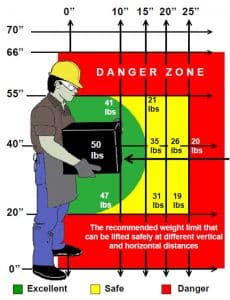Proper Lifting Techniques
Posted on: August 23, 2018

Before You Lift
PLAN AHEAD
- Know what you are lifting and how you will lift it.
- Be aware of the weight of the object.
- Determine whether or not it’s safe to lift on your own.
- Make sure the work area is flat, dry and clear of debris.
CHECK YOUR PATHWAY
- Make sure the lift pathway is clear.
- Remove any tripping hazards or debris.
- Check for any wet or slick surfaces.
USE ERGONOMIC EQUIPMENT
- Use lift assists, forklift, dolly, cart, hand truck or hoist.
- Make sure you are trained before using the equipment.
GET HELP WHEN NEEDED
- When lifting awkward or heavy loads, utilize a two-person lift.
- Make sure you lift at the same time and keep the load level.
WEAR PROPER PPE
- Wear proper required protective glasses, shoes, and gloves.
Basic Diagonal Lifting Technique
- Get as close to the object as possible.
- Use a wide stance with one foot forward and to the side of the object for good balance.
- Keep your back straight, push your buttocks out, and use your legs and hips to lower yourself down to the object.
- Slide the object as close to you as possible.
- Put the hand (same side of your body as the forward foot) on the side of the object furthest from you.
- Use this basic lifting technique for small objects when you can straddle the load and use a wide stance.
- Put the other hand on the side of the object closest to you. Your hands should be on opposite corners.
- Grasp the object firmly with both hands.
- Prepare for the lift, tighten your core muscles, look forward and upward, keep a straight and strong back.
- Lift slowly and follow your head and shoulders. Hold the load close to your body. Lift by extending your legs with your back straight, and breathe out as you lift.
Lifting Do’s and Don’ts
DO…
- Know or test the object weight.
- Use ergonomic lift assists when possible.
- Plan the lift and clear your path.
- Get help for heavy or awkward loads.
- Keep the object in the power zone.
- Use a wide stance for balance.
- Use your legs to lift.
- Pivot your feet to avoid twisting.
DON’T…
- Don’t hold your breath.
- Don’t bend or twist at the waist.
- Don’t use a partial grip (1-2 fingers).
- Don’t obstruct your vision when carrying.
- Don’t jerk or lift quickly.
- Don’t pinch your fingers or toes.
- Don’t pull a load if you can push it.
- Don’t forget to wear proper PPE
